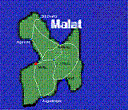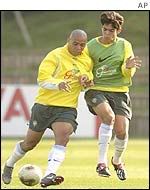Malat

| |
| Flag of Malat | |
| Motto: "Numa quadro numarus" | |

| |
| Region | Europe |
|---|---|
| Capital | Melita |
| Official Language(s) | Malatese |
| Leader | Fernando III |
| Population | n/a |
| Currency | Malatese lira |
| NS Sunset XML | |
The island of Malat is located off the southeast coast of Europe. It is a land of wide plains and rugged mountains, fertile farmlands and arid, rocky highlands. Malat boasts a rich cultural heritage that extends back over two millennia. In RL 2005, the people of Malat overthrew the ruling Counts and established a constitutional monarchy with fascist overtones.
Culture, people and language
Culture
Malat has been inhabited for millennia. Lying along sea trade routes along the southeastern coast of Europe, many different groups of people have come to the island. The Romans upon their arrival absorbed the indigenous people into their numbers. After the birth of Christ, Malat was also one of the focal points of the early Christian Church in southeastern Europe. The Moors arrived and introduced Islam and even later the crusaders brought back Christianity. The rising and falling tides of civilizations created a unique people of the Malatese. Given their position away from the continental conflicts, for most of the Middle Ages into the modern period, Malat was able to develop in relative isolation its culture.
</div>The Malatese people are in general friendly and strangers are often welcomed into homes for a refreshing drink of wine or something to eat. Cafés are a common sight in even the smallest villages where men and women meet for coffee and other local specialties. The national sport is football, with several professional and amateur leagues providing teams for all areas of the island. The Primero League's FC Melita and Cité Melleray engage in a rivalry that is followed all over Malat.
The people of Malat are quite devout, with most everyone attending some sort of religious service at least once a week. The principal faiths include Twentish Catholicism, Greek Orthodoxy, Islam and several varieties of Judaism.
People
The main ethnic group of the island is the Malatese people. Other groups such as the Moors, the Aragonese, French and Italians have all been largely absorbed, though foreign elements continue to survive among the aristocracy and through immigration from the mainland.
Ethnic groups
- 95% Malatese
- 2.5% Moors
- 2.0% Other
- 0.5% Jewish
Religious denominations
- 65% Twentish Catholicism
- 22% Orthodox Christian
- 12.5% Islam
- 0.5% Judaism
Language
The original language of the people of Malat (Old Malatese) before the Roman period has been lost as a complete language. The island was also home to a Greek colony at present-day Augustinople and the peoples of that area spoke ancient Greek. When the Romans came, the Latin alphabet was adopted and over time, the Malatese language adopted much from Latin to the point where linguists consider the result a Romance language. This is referred to as Malatese Latin and survives in several manuscripts and documents.
After the Roman withdrawal, the Moors arrived, bringing with them Arabic and their native languages. Malatese Latin adopted some elements from these influences, but retained its basic structure and syntax. With the crusader invasion bringing three new related Romance languages in Spanish, French and Italian, the Malatese Latin was enriched and is referred to as High Malatese. With the isolation of Malat after that through the Middle Ages into the modern period, Malatese came into its modern form that is spoken today.
The native dialects were suppressed in the aftermath of the Revolution of National Awakening. The Malatese National Revival Party believed that the various dialects had over time led to the factionalization of the island's population and allowed the lords of the different provinces to prevent the common people from uniting and rising up to overthrow their feudal masters. When the Party came to power in early RL 2005, it quickly passed a series of laws to make Malatese the only true language of Malat. In addition, certain languages such as Latin, Greek and Arabic were allowed to be taught in certain religious schools. However, Melleray-French was the key target of the laws on language, as Melleray had been the principal point of resistance against the Revolution.

]
Government and politics
The Second Malatese Republic was founded after the abdication of Fernando III of Melita and the death of Constance of Melleray.
Government
Under the Basic Law passed on RL 25 February 2005 by the National People's Assembly, a government of separated powers between the Legislative and Judicial came into being. The Executive powers are vested in a First Minister appointed by the legislative National People's Assembly. The judicial powers are vested in a National People's Court with lesser courts created as needed by the National People's Assembly.
The Kings and Queens of Malat in the new constitutional framework are to represent and serve as the symbol of the people. The monarch's final approval is required for all laws, but this cannot be withheld. Mariela of Melleray is the first Queen of Malat under the Second Republic.
Politics
Under the First Republic, political power was held by the Count and the Universita as an advisory body composed of the lords of the provinces. In the early-modern period, opposition parties of the people were suppressed by the government. The social democratic movement was brought into line by the Counts through the creation of various social programs, but not all political groups accepted such coercion.

The Partito Nazionale Di Rinascita Di Malat (PNRM) (Malatese National Revival Party) was founded in the city of St. Vittorio in RL 1931 by a group of college students who saw the regime of the Counta and provincial lords as a method of dividing up the Malatese people into regional groups with distrust for one another, thereby preventing any united action to overthrow the aristocracy.
The principal goals of the party were to unite the Malatese people and rebuild their cultural identity. One of the primary methods was to make Malatese the sole language and discourage use of regional dialects and foreign langauges in public life. In RL 2004, the PNRM orchestrated a national strike that in early RL 2005 saw the removal of the Counts from power and the creation of constitutional monarchy in a united Malat.
History
The original inhabitants of Malat were absorbed into the population of the Greek colony located at the site of modern Augustinople long before the Romans arrived. The Romans conquered Malat in 130 BC and held the island until the fall of the western Empire c. AD 500. The principal city of Melita was founded by them as their capital. At that point, the locals ruled themselves for about four hundred years. A certain Valerius living on the island settled at the site of the old Greek colony and refounded it as New Rome, though it came to be called Augustinople as Valerius had adopted the title of Augustus for himself. Melita had for a time been deserted due to an earthquake and coastal flooding from a tsunami. With the 'Catholic' faith centered at Melita and the 'Greek' faith at Augustinople, the 'Greeks' had more influence and quickly outnumbered the 'Catholics'.
In 723, the Moors crossed the sea and conquered the petty Roman state. They introduced Islam to Malat and though they did not actively persecute the Twentish and Orthodox Christians, the Moors actively worked to convert the peasantry. The Muslim dominion over the island continued for over three hundred years until 1045, when a crusade of French, Aragonese and Italian crusaders drove the Muslims from the island (though a substantial minority remained, having merged with the native Malatese population over time). The leader of the Aragonese contingent, Berengar I, named himself Lord of Melita and Count of Malat in 1045. He also began active measures to build the Twentish Catholic faith at the expense of the Orthodox Church, which had by then split away from its larger and more influential western cousin. The Lords of Melita maintained this dominance through most of the medieval period.
By the fourteenth century, the Lords of Melleray had become increasingly prominent in the affairs of the island and the coast of mainland Europe, where they had intermarried with the nobility of the nearer realms. In 1307, Lord Philippe used his influence to bring together the other two principal houses of the island, Rabat and St. Vittorio in a bid to remove the house of Melita from power.
The Universita, the council of the nobility since ancient times, was used as a vehicle to marshal the lesser houses and unite behind Philippe. A short civil war ensued, but quickly ended in the spring of 1308, when Berengar IV was forced to surrender the title of Count of Malat to Philippe, who claimed to rule by the acclamation of the Universita.
Upon Philippe's death in 1324, the Universita quickly declared Felipe IV of Melita the new count, removing any doubt that it would be responsible for electing the counts rather than have the title become hereditary.
Counts and Countesses of Malat
House of Melita
- Berengar (1012-1068)
- Felipe (1035-1094)
- Berengar II (1057-1098)
Assassinated by order of his son Ramon
- Ramon (1077-1132)
- Pedro (1101-1150)
- Felipe II (1139-1202)
- Berengar III (1157-1219)
- Ramiro (1192-1231)
- Ramon II (1217-1239)
Died in a 'fall'
- Felipe III (1219-1281)
Younger brother of Ramon II
- Pedro II (1253-1304)
- Berengar IV (1282-1343)
Overthrown by Philippe of Melleray in 1308
Elected by the Universita
- Philippe (V) (1280-1324 - Melleray)
- Felipe IV(IV) (1299-1361 - Melita)
- Vincenzo (VIII) (1320-1384 - St. Vittorio)
- Giovanni (VI) (1345-1410 - St. Vittorio)
- Ali ibn Faisal (1358-1418 - Rabat)
- Berengar V(V) (1395-1457 - Melita)
- Anne (1401-1468 - Melleray)
- Abdullah II (1421-1491 - Rabat)
House of Melita-Algericas
- Alfonso IV (1439-1503 - Algericas)
- Ramiro III (1482-1516 - Melita)
Son-in-law of Alfonso IV
- Renaldo III (1490-1555 - Algericas)
Son of Alfonso IV
- Berengar VI (1514-1575 - Melita)
Son of Ramiro III
- Renaldo IV (1535-1596 - Algericas)
Son of Renaldo III
- Antonio II (1561-1629 - Algericas)
Son of Renaldo IV
Elected by the Universita
- Henry III (1592-1652 - Melleray)
(The List needs to be completed.)
- Alfonso VIII (1869-1931 - Melita)
- Cristobal II (1931-1944 - Algericas)
- Constance (1944-1976: 1st time - Melleray)
Retired to attend to family affairs
- Giovanni XI (1976-1995 - St. Vittorio)
- Fernando III (1995-2005 - Melita)
Abdicated and fled with family to Great Britannia
- Constance (2005: 2nd time)
Assasinated by fascist agents shortly after election as Countess
Kings and Queens of Malat
- Mariela (2005-present)
Granddaughter of the last Countess
- Eduardo Cortez (2005-present) - Regent during Mariela's exile in Erlangen-Ansbach

